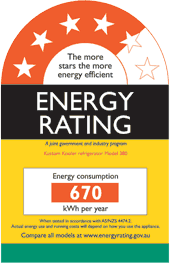Energy rating label
From Wikipedia, the free encyclopedia

A typical energy rating label.
In Australia and New Zealand an energy rating label is a type of energy input labeling used on various appliances. It allows consumers to compare the energy efficiency between similar products.
The label was introduced in 1986 in New South Wales and Victoria and later its use was extended to all states and territories. A mandatory, national labelling scheme was agreed to in 1992. This placed Australia as the third country to establish such a system, after Canada and the United States.[1]
An International Energy Agency survey revealed that compliance by retailers showing the labels was raised from 94% in 2001 to 98% in 2009.[2]
See also
- Energy policy in Australia
- Electricity sector in New Zealand
References
- ↑ "History of the labelling program in Australia". Commonwealth of Australia. 2 February 2009. Retrieved 11 June 2011.
- ↑ "Energy rating labels success". Bigpond News. 13 October 2010. Retrieved 11 June 2011.
External links
- Energy labelling at the Australian Department of Climate Change and Energy Efficiency
- Energy rating labels at the New Zealand Energy Efficiency and Conservation Authority
- Energy rating labels at EECA Energywise
| |||||
This article is issued from Wikipedia. The text is available under the Creative Commons Attribution/Share Alike; additional terms may apply for the media files.